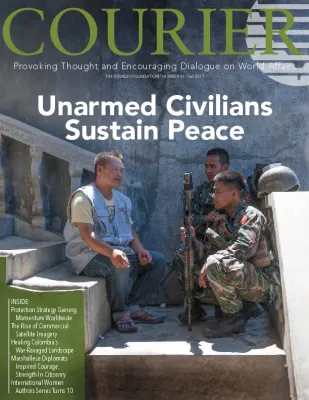"Displaced women faced enormous risks each time they left the Protection of Civilians site in Bentiu, South Sudan, in August 2015. In an attempt to address the growing number of reported rapes of firewood collectors, Nonviolent Peaceforce’s team in Bentiu began to accompany larger groups of women deep into the bush toward Borbor, approximately two hours northwest. Team Bentiu’s aim, along with providing direct protection, was to identify which routes women typically took when they venture outside the protection site. The team could then provide GPS coordinates to the United Nations Mission in South Sudan, with the aim of getting the mission to increase its presence on those routes. (Nonviolent Peaceforce photo) Panic was nowhere to be found a few years ago, as a Philippine army patrol and a patrol of the Moro Islamic Liberation Front were converging on a village on the island of Mindanao. This was not the groups’ first incursion, and the people of the village had been trained in early warning/early response techniques. As the patrols neared, the village implemented a protection strategy, which included calling on a group from my organization, Nonviolent Peaceforce, as well as the local civilian-protection team, Bantay Ceasefire, which was monitoring a nearby post. En route to the village, the civilian-protection team called the local commanders of both armed groups. The team told the patrols they must have made a mistake getting so close to the village. The team also said it knew the armed groups didn’t want to scare civilians and, furthermore, that the commanders knew such action violated the ongoing ceasefire. To assure that things would go okay, the civilian protectors said they would stay in the village. By the time the protectors arrived, the patrols had backed off, and 600 people had stayed home instead of becoming internally displaced persons. Civilian peacekeeper Badrodin Mananggolo of Nonviolent Peaceforce speaks with soldiers from the Armed Forces of the Philippines on March 26, 2013, in Malabang, Philippines. Civilian peacekeeper Badrodin Mananggolo of Nonviolent Peaceforce speaks with soldiers from the Armed Forces of the Philippines on March 26, 2013, in Malabang, Philippines. (Nonviolent Peaceforce photo) More and more of these stories are coming from areas of violent conflict throughout the world as unarmed civilian protection (UCP) emerges as an effective strategy to directly protect civilians. According to Selkirk College’s database on UCP, 39 nongovernmental organizations are nonviolently protecting civilians in 21 countries, including Myanmar, Iraq, South Sudan, and the United States. UCP includes a series of methods for the direct protection of civilians, localized violence reduction, and support for local infrastructures for peace. While not appropriate in every situation, UCP can be employed in a number of places where armed peacekeepers cannot or will not go. For example, civilian protectors accompany women as they collect firewood in the bush of South Sudan so soldiers don’t rape them. UCP teams also provide a protective presence for the civilian fleeing fighting in Iraq, monitor the ceasefire in Mindanao, accompany Palestinians in need of hospitalization through Israeli checkpoints, protect communities of peace in Colombia, and interrupt gang violence in Chicago."
Publisher(s)
Publication year
2017
Abstract
ACCESS
File
Document
Access
“Open” means that the resource is available to view, but please check the weblink for restrictions on use. “Restricted” means that the resource is not openly accessible to all, but you can purchase a copy, or your organisation might have an institutional subscription.
Source
Courier - No. 91, Fall 2017
FURTHER INFORMATION
Keywords
Organisation(s)
Country
Language(s)
